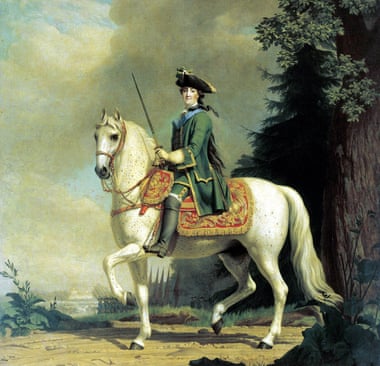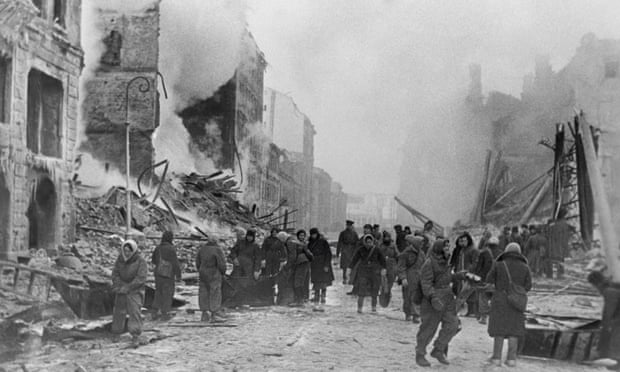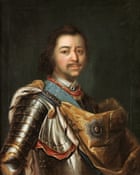The Story of Russia by Orlando Figes review – what Putin sees in the past | History books
Anyone who has wandered through Russia’s national museums, leafed through books of Russian art or watched some of Eisenstein’s cinematic masterpieces will know that prominent among the country’s iconography are arresting portraits of its princes and tsars.
There is the imagined baptism of Grand Prince Vladimir, whose conversion to Christianity in the 10th century was – in Russian eyes – the foundation stone of Russian Orthodoxy and the birth of the Russian state. There is the warrior prince, Alexander Nevsky, who fought off the Swedes and the Teutonic knights. There are contrasting portraits of Ivan the Terrible, one proud and mistrustful, the other of a deranged monarch cradling the son he killed. And there are the grand 18th-century sovereigns Peter the Great and Empress Catherine.
Whether intended to elevate the subjects to hero status or castigate them as cruel tyrants, these pictures form part of Russia’s collective memory. They are etched into the nation’s psyche, each capturing a moment in Russia’s story about itself.
And this is the starting point of Orlando Figes’s The Story of Russia: “Russia is a country held together by ideas rooted in its distant past,” he tells us in the introduction. “Histories continuously reconfigured and repurposed to suit its present needs and reimagine its future.”
Inevitably in a survey of more than 1,000 years of history, much has had to be skirted over or omitted. But this book’s purpose is not to fill in all the blanks. It is to examine the recurring themes and myths that drive Vladimir Putin’s conviction that war with Ukraine and with western Europe is part of Russia’s historical destiny. For those unfamiliar with the past, this is an indispensable manual for making sense of Russia’s present.
And this is very much Russia’s story. Figes makes no apology for referring to Kiev not Kyiv, or Prince Vladimir nor Volodymyr, as the Ukrainians would have it. He is not interested in how the Tatars in Kazan see the sacking of their city by Ivan the Terrible, or what the Chechens or Georgians make of the Russian tales of war in the Caucasus. All that might be the subject of another book. But this, as the title tells us, is one country’s story about itself.

Fundamental to this, naturally, is its founding legend. And even this origin story, it turns out, has long been the subject of controversy: was it Slavic peoples who first settled what became known in Russia as Kievan Rus? Or was it Scandinavian, Baltic or even Germanic tribes who provided the first rulers? Was ancient Russia, in other words, created by Russians or foreigners? The historical facts are, inevitably, more complex still. Figes concludes: “It is absurd to claim that Kievan Rus was the birthplace of the modern Russian state or nation.” He likens it to the place Anglo-Saxon Wessex has in English history – one element, but not the whole story.
Another strand, exploited through the centuries by successive rulers to enhance their authority, is the idea of spiritual exceptionalism. It was Ivan the Terrible, no less, who adapted Byzantine rituals to create an imperial myth – that the tsar was anointed by church and god, and that Moscow was the Third Rome, the rightful successor and true capital of Christendom after the fall of Rome and Constantinople.
Fast forward to the 20th century and note Stalin’s use of religion on the eve of the second world war, replacing Bolshevik slogans with religious iconography and enlisting the support of the Orthodox church to rally support for the motherland against the Nazis. We see the same echoes again today in Putin’s “holy war” against Ukraine.
But the idea that Russia has a sacred spiritual destiny sits uneasily with its sense of where it fits into the world. As Figes meticulously charts, throughout its history there has been a running debate about how the country relates to foreigners and, above all, to Europeans. Did Russia really languish under the Tatar yoke after the Mongol invasion, held back by lack of access to the European Renaissance, as the “Westernisers” would have it? Or did isolation from Europe allow Russia to preserve its eastern Byzantine inheritance, untainted by western secularism and individualism, as their opponents, the so-called “Slavophiles” claim? No wonder Peter the Great, the tsar who forced his nobles to shave off their beards and abandon their kaftans for European garb, was a polarising figure.

So where does Putin stand in all this? We know he is obsessed with Russian history – hardly surprising, given that he grew up in what was once the imperial capital, St Petersburg. As Figes reminds us, it is a city redolent with symbolism. Built by Peter the Great out of the marshes, it turned Russia’s gaze westward. Until 1917, it was the nucleus of the Russian tsarist empire. And with the siege of Leningrad in the second world war, it became a searing emblem of Russia’s capacity for heroism and sacrifice.
How could the young Putin, walking through his home city, not be struck by the contrast between its monuments to Russia’s past and the deprivations of his own Soviet era? How could he not ponder the meaning of the majestic statue of the Bronze Horseman (the subject of Pushkin’s masterful poem of the same name) – a tsar mounted on a rearing horse, surveying the threats Kremlin leaders have always feared: invasion from abroad or an uprising by the restive masses?

Surely these visions must have shaped Putin’s thinking. As far back as 2001, he revealed in a BBC interview that he was reading biographies of Peter the Great and Empress Catherine, the two most successful rulers of the Russian empire in the 18th century – and the most pro-European. He has delved deeper into history, drawing on other examples to lecture the world on the long history of Russia’s fractious relations with the west and with the land that sits in between – Ukraine.
So has Putin turned his back on Peter and embraced a Slavophile vision, believing Russia’s destiny lies away from Europe, with the war in Ukraine the pivotal moment in which the rift is cemented? Or does he think Russia will one day return to the greater European family if, in some mind-boggling way, he can turn the Ukraine invasion to his advantage?
Figes attempts to answer this in his final chapter: how does the story of Russia end, and how far will its future continue to be shaped by its past? In the midst of the current uncertainty and turbulence, this is no easy task. What Figes does note – correctly in my view – is that Putin’s approach to history is somewhat “pick-and-mix”, a postmodern selection of what fits his current purpose, shape-shifting along with his policies to adapt to changed circumstances. The question we are left with is whether Putin is still able to control the narrative, or if he has become a victim of his own myths about the “Russian world”.
Anyone who has wandered through Russia’s national museums, leafed through books of Russian art or watched some of Eisenstein’s cinematic masterpieces will know that prominent among the country’s iconography are arresting portraits of its princes and tsars.
There is the imagined baptism of Grand Prince Vladimir, whose conversion to Christianity in the 10th century was – in Russian eyes – the foundation stone of Russian Orthodoxy and the birth of the Russian state. There is the warrior prince, Alexander Nevsky, who fought off the Swedes and the Teutonic knights. There are contrasting portraits of Ivan the Terrible, one proud and mistrustful, the other of a deranged monarch cradling the son he killed. And there are the grand 18th-century sovereigns Peter the Great and Empress Catherine.

Whether intended to elevate the subjects to hero status or castigate them as cruel tyrants, these pictures form part of Russia’s collective memory. They are etched into the nation’s psyche, each capturing a moment in Russia’s story about itself.
And this is the starting point of Orlando Figes’s The Story of Russia: “Russia is a country held together by ideas rooted in its distant past,” he tells us in the introduction. “Histories continuously reconfigured and repurposed to suit its present needs and reimagine its future.”
Inevitably in a survey of more than 1,000 years of history, much has had to be skirted over or omitted. But this book’s purpose is not to fill in all the blanks. It is to examine the recurring themes and myths that drive Vladimir Putin’s conviction that war with Ukraine and with western Europe is part of Russia’s historical destiny. For those unfamiliar with the past, this is an indispensable manual for making sense of Russia’s present.
And this is very much Russia’s story. Figes makes no apology for referring to Kiev not Kyiv, or Prince Vladimir nor Volodymyr, as the Ukrainians would have it. He is not interested in how the Tatars in Kazan see the sacking of their city by Ivan the Terrible, or what the Chechens or Georgians make of the Russian tales of war in the Caucasus. All that might be the subject of another book. But this, as the title tells us, is one country’s story about itself.

Fundamental to this, naturally, is its founding legend. And even this origin story, it turns out, has long been the subject of controversy: was it Slavic peoples who first settled what became known in Russia as Kievan Rus? Or was it Scandinavian, Baltic or even Germanic tribes who provided the first rulers? Was ancient Russia, in other words, created by Russians or foreigners? The historical facts are, inevitably, more complex still. Figes concludes: “It is absurd to claim that Kievan Rus was the birthplace of the modern Russian state or nation.” He likens it to the place Anglo-Saxon Wessex has in English history – one element, but not the whole story.
Another strand, exploited through the centuries by successive rulers to enhance their authority, is the idea of spiritual exceptionalism. It was Ivan the Terrible, no less, who adapted Byzantine rituals to create an imperial myth – that the tsar was anointed by church and god, and that Moscow was the Third Rome, the rightful successor and true capital of Christendom after the fall of Rome and Constantinople.
Fast forward to the 20th century and note Stalin’s use of religion on the eve of the second world war, replacing Bolshevik slogans with religious iconography and enlisting the support of the Orthodox church to rally support for the motherland against the Nazis. We see the same echoes again today in Putin’s “holy war” against Ukraine.
But the idea that Russia has a sacred spiritual destiny sits uneasily with its sense of where it fits into the world. As Figes meticulously charts, throughout its history there has been a running debate about how the country relates to foreigners and, above all, to Europeans. Did Russia really languish under the Tatar yoke after the Mongol invasion, held back by lack of access to the European Renaissance, as the “Westernisers” would have it? Or did isolation from Europe allow Russia to preserve its eastern Byzantine inheritance, untainted by western secularism and individualism, as their opponents, the so-called “Slavophiles” claim? No wonder Peter the Great, the tsar who forced his nobles to shave off their beards and abandon their kaftans for European garb, was a polarising figure.

So where does Putin stand in all this? We know he is obsessed with Russian history – hardly surprising, given that he grew up in what was once the imperial capital, St Petersburg. As Figes reminds us, it is a city redolent with symbolism. Built by Peter the Great out of the marshes, it turned Russia’s gaze westward. Until 1917, it was the nucleus of the Russian tsarist empire. And with the siege of Leningrad in the second world war, it became a searing emblem of Russia’s capacity for heroism and sacrifice.
How could the young Putin, walking through his home city, not be struck by the contrast between its monuments to Russia’s past and the deprivations of his own Soviet era? How could he not ponder the meaning of the majestic statue of the Bronze Horseman (the subject of Pushkin’s masterful poem of the same name) – a tsar mounted on a rearing horse, surveying the threats Kremlin leaders have always feared: invasion from abroad or an uprising by the restive masses?

Surely these visions must have shaped Putin’s thinking. As far back as 2001, he revealed in a BBC interview that he was reading biographies of Peter the Great and Empress Catherine, the two most successful rulers of the Russian empire in the 18th century – and the most pro-European. He has delved deeper into history, drawing on other examples to lecture the world on the long history of Russia’s fractious relations with the west and with the land that sits in between – Ukraine.
So has Putin turned his back on Peter and embraced a Slavophile vision, believing Russia’s destiny lies away from Europe, with the war in Ukraine the pivotal moment in which the rift is cemented? Or does he think Russia will one day return to the greater European family if, in some mind-boggling way, he can turn the Ukraine invasion to his advantage?
Figes attempts to answer this in his final chapter: how does the story of Russia end, and how far will its future continue to be shaped by its past? In the midst of the current uncertainty and turbulence, this is no easy task. What Figes does note – correctly in my view – is that Putin’s approach to history is somewhat “pick-and-mix”, a postmodern selection of what fits his current purpose, shape-shifting along with his policies to adapt to changed circumstances. The question we are left with is whether Putin is still able to control the narrative, or if he has become a victim of his own myths about the “Russian world”.
